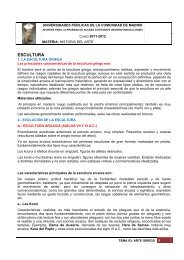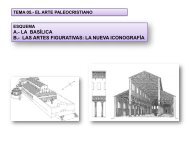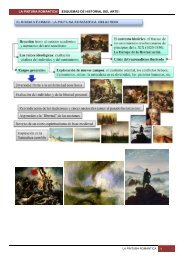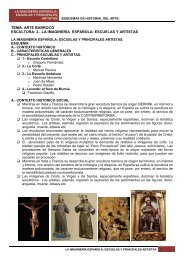You also want an ePaper? Increase the reach of your titles
YUMPU automatically turns print PDFs into web optimized ePapers that Google loves.
Historia <strong>de</strong>l Arte<br />
CIMBORRIO: Torre <strong>de</strong> planta poligonal o cuadrada cubierta con cúpula. Suele situarse en el<br />
crucero <strong>de</strong> las iglesias. Este cimborrio suele <strong>de</strong>scansar sobre pechinas o trompas.<br />
Interiormente la cúpula suele estar reforzada <strong>de</strong> arcos. Son características las <strong>de</strong> Zamora y<br />
Toro [ provincia <strong>de</strong> Zamora ]<br />
CLAUSTRO: patio interior y galería que ro<strong>de</strong>a una iglesia o un monasterio. Espacio<br />
distribuidor <strong>de</strong> diferentes <strong>de</strong>pen<strong>de</strong>ncias <strong>de</strong>ntro <strong>de</strong> un monasterio. Solía tener jardines y una<br />
fuente. Un espacio para pasear y reflexionar.<br />
CONTRAFUERTE: trozo <strong>de</strong> muro adosado a la p<strong>arte</strong> exterior <strong>de</strong> las construcciones románicas<br />
cuya finalidad es servir <strong>de</strong> refuerzo exterior para evitar las presiones internas.<br />
CRUCERO: espacio don<strong>de</strong> se cruzan la nave principal <strong>de</strong> una iglesia y el brazo <strong>de</strong>l transepto<br />
Suele estar cubierto con cúpula y en el exterior suele aparecer un cimborrio









